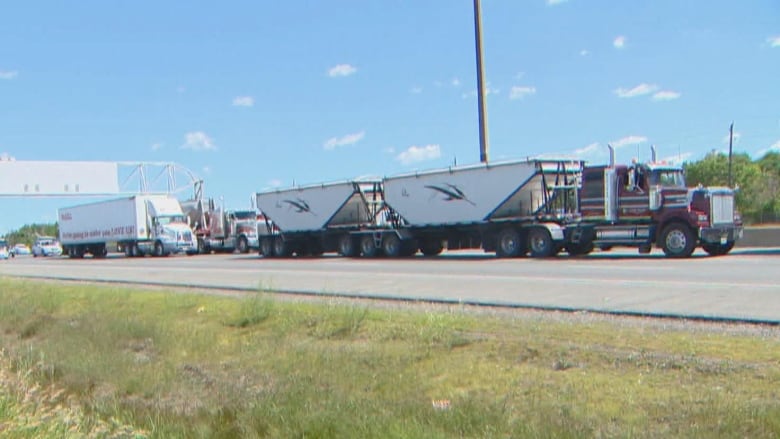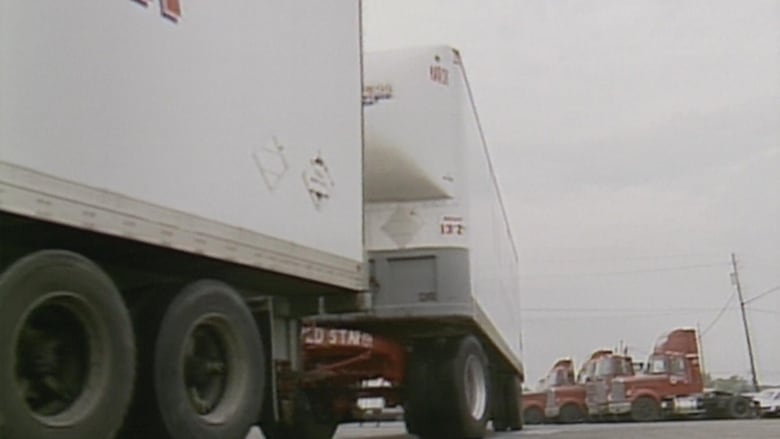Ontario government proposing changes to current regulations

CBC
The proposed plans would allow 40-metre, double-trailer trucks on GTA highways during rush hour.
Ontario’s government wants to let double-trailer transport trucks on the highways during peak traffic times in the GTA.
Currently these trucks, known as “long-combination vehicles,” are not allowed on highways between 7:30 and 9 a.m. or 4:30 to 6 p.m.
But the Progressive Conservative government is proposing a change to make things easier for trucking companies.
The government said the change will help the economy, and that long-combination trucks have more safety restrictions and fewer collisions than single-trailer trucks.
The government disputed the idea that allowing double-trailer trucks would make the roads more congested; saying instead that these larger trucks can carry double the goods so there will be fewer trucks on the road overall.
“This will reduce the amount of commercial vehicles,” said Kinga Surma, associate minister of transportation.
She also said that allowing double-trailer trucks during rush hour would be “good for the environment” and would reduce emissions.
1,600 double-trailer trucks in Ontario
Long-combination vehicles have been in a pilot phase in Ontario since 2008 and there are 1,600 already driving in Ontario, Surma said.
These trucks already drive during a lot of heavy traffic, said Mike Millian, president of the Private Motor Truck Council of Canada.

Makda Ghebreslassie/CBC
Kinga Surma, associate minister of transportation, said the change will have economic and environmental benefits.
This change just gives truck drivers “more flexibility in their day.”
Drivers worry about congestion, safety
Some Ontario drivers are worried about the plan.
“There’s already enough [congestion] during rush hour,” said Randy Cox, filling up at one Toronto gas station.
Victoria Crawford said the idea makes her nervous.
“I don’t feel safe having any large trucks on the highway during rush hour,” she said.
“I don’t do highways because I’m afraid of trucks,” said Norma Laig.
‘Safest drivers on the road’
But Millian said safety won’t be compromised with the change. He said long-combination vehicles have lower accident rates, speeds are limited to 90 km/hr, and the trucks have heavy signage.
These drivers have to go through “extensive training,” he said.
These are the “safest drivers on the road.”
LCVs can now carry some dangerous goods
These trucks would also be able to carry extra materials under the new rules.
Previously, LCVs couldn’t carry any dangerous goods. But under the proposed plans, the trucks would be allowed to carry some dangerous goods like cleaning agents and battery acids, Millian said.
Highly explosive materials and tankers would still be restricted, he said.
Surma said the minister has been consulting with the public and small businesses on the decision. The change is part of a package of government plans to “reduce regulatory burdens” in Ontario.
The change is currently before committee, Surma said, and there will be more consultations before it returns to the House.

CBC
Double-trailer trucks are known as long-combination vehicles.
“I don’t see it as simply adding more trucks to the road,” said Roorda, an engineering professor at the University of Toronto.
“It is changing the configuration of trucks.”
Roorda said he believes the number of trucks on the road is based on how much needs to be transported. This change gives companies the option to be more efficient, he said.
Roorda said he would also like to see other changes, such as changing noise bylaws so trucks can operate later in the day and changing parking policies so drivers can have more options for resting.
LCVs are also not permitted to drive in Ottawa during rush hour.
With files from Makda Ghebreslassie and Laura Howells
Source: CBC News
